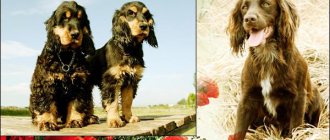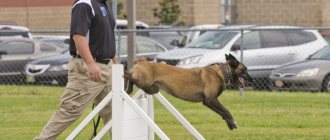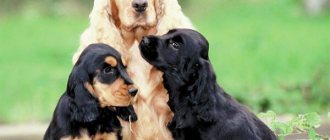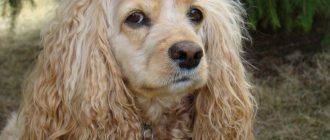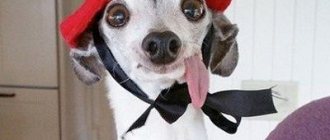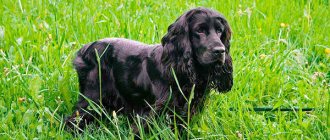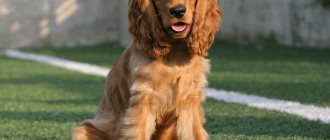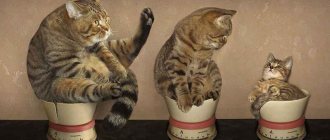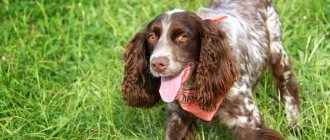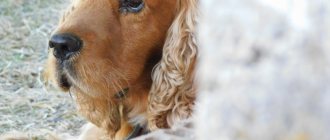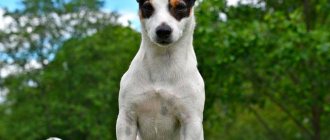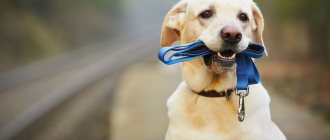Aboriginal breeds develop in close contact with local residents. This gives them the opportunity to better understand the person and adapt to his needs. The Kooikerhondje (Dutch Spaniel) is famous for its ability to anticipate the desires of the hunter. The Dutch are no less sensitive when it comes to their family. Kooikerhondje combines the functions of a hunter, watchman and companion.
English springer
The breed can be called the progenitor of all living Spaniels - the most ancient companion and hunter of the English nobility is the Springer. A large dog, reaches 46-56 cm at the withers and weighs up to 30 kg. Stately, muscular, strong, but graceful in movement, light and fast. Dogs were especially popular during the Renaissance: great artists painted them on canvas and described them in novels.
A good family pet: kind, loyal, active, devoted. The best friend for children, a partner for running and playing. Suitable for active people with free time for walking and hunting.
Springers cannot be left alone for a long time: they begin to whine, bark, and destroy everything around them. Recently, there has been a tendency towards increased incidence of rage syndrome. This is a neurological disease related to epilepsy. At the moment of an attack, the dog does not distinguish between commands and does not understand where it is, and attacks its owners for no reason.
Health
The Dutch have good health, but are prone to genetic pathologies. This is due to the small number of the breed. The most common diseases include:
- von Willebrand disease (blood clotting disorder);
- cataract;
- dislocation of the kneecap;
- epilepsy;
- neuromuscular disorders;
- obesity.
Average life expectancy: 12-14 years.
Tips for caring for Kooikerhondje
- Wool.
Waterproof double wool repels dirt and requires little care. But if you are preparing your dog for an exhibition event, then full grooming is needed. First of all, it's swimming. Before the procedure, the dog is combed well. Then they bathe with shampoo for long-haired dogs and apply a special conditioner cream. Afterwards, all this cosmetics must be thoroughly washed off. Next, the Kooikerhondje dog is combed with a coat softener and dried with a hairdryer in the direction of hair growth. In daily care, wash the dog once every one or two months. As a rule, they are combed out with a slicker brush, but not too often and intensively. - Ears.
Since the dog is used for hunting purposes and is very mobile, water and foreign particles can get into the animal’s ears while hunting or running through bushes and tall grass. Therefore, in order to avoid otitis media and various other troubles, the ears need to be systematically checked and, if necessary, cleaned. The easiest way: the ear is shallowly filled with a special lotion, gently massaged, and the dog, shaking its head, mechanically removes everything unnecessary. - Eyes
. If dust or dirt gets into the animal's eyes, wipe them towards the inner corner of the eye. This procedure is performed using a cotton pad or a piece of natural cotton fabric. - Teeth.
Get your puppy used to brushing his teeth from an early age, this way you will avoid dental problems. Pet stores will help you choose all the necessary pastes and brushes. Pamper your beloved Kooikerhond with teeth cleaning bones. They come in: edible from natural ingredients, and in the form of funny toys made from special materials. Their shapes and sizes are also varied. The selection is made taking into account the characteristics and preferences of your dog. - Claws.
These energetic dogs usually walk, run and jump a lot, and their nails wear down on their own. In other circumstances or if kept in an apartment for a long time, the claws should be trimmed with a nail clipper or filed with a file. The claws on the dewclaws (if any) of the animal are trimmed regularly. - Walks.
If a Kooikerhondje dog is kept in a private house, the area should be fenced so that it cannot escape into the street. On walks outside the home in the city, the pet is only walked on a leash, although it does not like it. - Toilet.
These funny dogs are very smart animals and they very quickly understand that they need to do their business outside. But puppies can be taught to relieve themselves outside the apartment only after scheduled vaccinations. Until that time, the pet’s body has not yet adapted and it can catch all sorts of infectious and very life-threatening diseases. - Feeding.
First of all, the Kooikerhondje is a hunting dog and therefore needs meat. It should not be fatty, preferably: beef, lamb, chicken, turkey. You need to diversify the animal's diet with offal (liver, lungs, heart), cereals (buckwheat, egg, wheat), fermented milk products (cottage cheese, kefir) and some vegetables (carrots, apples).
Many people believe that if a dog is a hunting dog, then it should be given bones. They say this is what our ancestors always did after a successful hunt. This is a very dangerous misconception. Firstly, the dog’s intestines become clogged with undigested bone remains, and secondly, bird bones are so sharp that they can cut the stomach and intestines. So don’t take risks, take care of the health of your beloved pet.
Living and maintenance conditions
The description of the English Cocker Spaniel breed speaks of the medium size of the dog, which allows it to be kept in an apartment. We will discuss the features of caring for it, taking into account the character of the eared pet, below.
Top articles: How do hummingbirds fly in wind and rain?
Care
The place for the dog should be located away from heating devices and passages with drafts. It is not recommended to purchase newfangled baskets with high sides; the puppy simply will not be able to climb up there.
This can be a soft and warm bedding made from natural materials. Babies do not tolerate loneliness well, they get bored and cry - if you do not want your dog to be left with psychological trauma, do not leave the little one alone for a long time.
It is advisable to remove electrical wires from his field of vision: like all children, he is curious, and trouble is not far away.
Buy him several toys, soft and rubber; choose natural, non-allergenic materials.
Wool and proper haircut
Spaniels have thick, long hair that is prone to tangling and matting. To care for it, you need a thick massage-type brush with natural bristles.
At six months of age, shedding begins - it is important to remove fluff so that it does not interfere with hair growth
Hair also grows on the paws between the pads, which needs to be trimmed, otherwise during a walk all sorts of plant and other debris will cling to it. Worst of all, if anything sharp in it cuts the skin, an infection may occur.
When cutting fur, purchase safety scissors with round tips. Let the puppy get used to their sound, so that in the future the procedure will proceed smoothly, without incidents.
As for fur allergies, numerous studies have found that there are no completely hypoallergenic dogs - if the irritants are not in the fur, they may be in the dog's saliva.
Scientists from the French Academy "Aix-Marseille", which deals with health issues, conducted studies on the presence of allergens in dog hair. The research involved 288 dogs of different breeds and both sexes.
During the experiments, it was found that the lowest coefficient of allergens was found in Labradors, retrievers, spaniels and cocker spaniels.
Ears, eyes, teeth, claws
Long and fluffy ears require especially careful care. They need to be checked after a walk and regularly cleaned of wax accumulation using cotton pads and swabs. Be careful not to damage the delicate skin of the ear canal.
For long-eared pets, it is advisable to purchase plates on a stand so that their ears do not get into the food.
Use special pharmaceutical drops to wipe the pet's eyes, each separately, to avoid infection.
Twice a week you need to brush your teeth with special brushes and toothpastes (available at any veterinary pharmacy or pet store). The color of healthy gums is pink. If the gums are swollen, pale or red, and there is a stench coming from the mouth, the dog should be taken to the veterinarian.
To care for your claws, purchase a special nail clipper and nail file. Cut off what extends beyond the surface of the pad as it grows. To prevent the dog from injuring itself, the edges of the cut are filed.
Bathing
How often you bathe your pet depends on its behavior on the street: if it gets dirty in a puddle or in something “pleasantly” smelling, water treatments with dog shampoo cannot be avoided. In general, there is no need for frequent bathing, and paws should be washed after every walk.
Walks
Ideally, you should walk your pet three times a day. Please note that your pet will relieve itself literally every ten minutes, since their bladder does not empty immediately.
If the walk is intense - with running, games, training exercises - then an hour in one session is enough. You should not put overalls or blankets on your dog; they have quite thick fur.
Nutrition
When feeding with ready-made food, choose dry, semi-dry food and canned food.
You need to choose well-known brands, because, caring about their reputation, in nutrition they take into account everything that is necessary for the development, growth and health of the animal.
Important! It is recommended to eat three meals a day in small portions: this way the pet will never be hungry, since the digestion process in dogs lasts about eight hours. This approach to feeding will not make the dog want to pick up all sorts of nasty things on a walk.
If you decide to feed natural products, then the diet should include:
- boiled meat, preferably lean; chopped vegetables or dried fruits are added to the meat;
- among dairy products, cottage cheese, yogurt and kefir are preferable, but in small quantities to avoid indigestion;
- eggs, either boiled or raw;
- porridge: rolled oats, rice, millet, buckwheat;
- meat by-products - only in boiled form.
Training
The Kooikerhondje breed is considered one of the smartest, therefore, an experienced owner should not have any difficulties training it.
It is very important that the animal is socialized in the right conditions. Household members should not treat him rudely or impolitely
This animal is extremely vulnerable. It will not give its offender a physical rebuff, but it will never be able to trust him after the discomfort caused.
These dogs need careful handling. If there is a good-natured and welcoming atmosphere in the house where they live, they will become obedient and will happily follow all the owner’s commands. Important rules for raising a Kooikerhondje:
- Never give him food from the table.
- Don't let him sleep next to you or climb onto your bed.
- Respect your dog's choice if he chooses the company of animals over your company.
- When she obeys and behaves well, reward her.
- Don't let your dog bark for no reason.
- Encourage his curiosity.
- Supervise the animal when it is walking without a leash.
If you violate these rules, you risk spoiling your pet. In this case, he will not stop loving you, but he will definitely not respect you. Remember, the dog should not be afraid of people. He should understand that a person occupies a dominant position in the family, that is, in his pack. To help him learn this, tell him that there are rules in the house that he cannot break.
A well-mannered dog will never take a shit. When the need to empty the bladder arises, he must ask to go outside. When the dog relieves itself in the yard, be sure to praise it, and if it does it in the house, then scold it.
Make sure that the animal does not chew the furniture. Some puppies, when their teeth are growing, begin to chew everything that gets in their way.
To prevent their attention from being drawn to household objects, purchase a soft toy or rubber ball. Let the dog know that he has a personal item, it will make him happy
If he growls at the moment when you try to take it away, scold the animal. It should not show aggression towards anyone.
The ideal option for Kooikerhondje training is a trip to the dog playground. Unfortunately, there are few of these in Russia, so you can build something like a “simulator” for your dog. This could be a small wooden ledge that she will have to jump over.
Install it outdoors. Run a few laps with your dog to cheer him up, and offer to use the “simulator”. If he gets scared, demonstrate the jump to him in person. The animal will see that performing this exercise is not at all scary and will do what he expects.
Sports exercises will bring joy not only to the Kooikerhondje, but also to its owner. The animal loves spending time together, therefore, it willingly agrees to any load.
Relationships with people and animals
Kooikerhondje also doesn’t like children. He will get angry if some baby pulls his fur. Therefore, it is better not to leave them alone. But, you can be absolutely sure of the good-natured intentions of this beast.
Whatever his attitude towards a particular person, he will never harm him, that is, he will not bite. The breed has a high level of adaptation. Wherever you go with Kooikerhondje, he will feel comfortable next to you.
Papillon (Continental Toy Spaniel)
It is completely different from its brothers: small (up to 28 cm at the withers), with long hair and erect ears, for which it received its name. “Papillon” is translated from French as “butterfly”; the silhouette of the ears, together with long fringes, form the “wings” of a moth. The Papillon's closest relative is the Phalene ("waterfall"), this breed has drooping ears.
Dogs appeared in France, they immediately won the love of the French court and even King Henry III. Animals roamed freely around the palace, they were painted by famous artists, and society ladies could not appear at a reception without a basket with adorable puppies.
Their small size and cunning allow Papillons to manipulate their owners. Animals need proper upbringing and training, then they will become good pets, loyal friends, and agile performers. Average cost of a puppy: 40-80 thousand rubles.
How and what to feed
Feed your Kooikerhondje a balanced, high-quality diet for long-term health and happiness. Generally speaking, the breed needs two proportionate meals per day. Like all dogs, they love treats, but they must be limited.
pros
- Not too excitable
- Wool does not require complex care
- Small size for active breed
Minuses
- Limited Breeders
- Strong prey drive
- Shy about strangers without proper socialization
About the breed
The breed is considered to be of native English origin.
As early as the 13th century, dogs such as the Norwich Terrier and the Dachshund were used for hunting. Their main purpose was small game in the swampy thickets and dense forests throughout the territory of the modern kingdom. As already mentioned, a novice dog breeder may not even suspect that Cocker Spaniels come in English and American varieties. The origin story of the latter began with the European conquest of the New World. Many of them migrated there with their pets, including many dogs, and spaniels in particular. Spaniels received the prefix from the most frequently brought prey of the woodcock (wood cockerel)
Until the mid-30s of the last century, these two breeds were not separated, but then English dog handlers insisted on their own. For centuries they have cultivated a high level of performance in animals, paying virtually no attention to appearance. Whereas in America they did everything the other way around. Appearance was put at the forefront, and performance was simply forgotten. This is why the American Cocker Spaniel has a more elegant appearance.
But their colors are almost similar. Read more about this in the articles:
- English Cocker Spaniel colors;
- American Cocker Spaniel colors.
American and English Cocker Spaniel: differences
Externally, both breeds are very similar and this is explained by common roots. But there are a number of differences. Let's take a closer look at how the English Cocker Spaniel differs from the American one.
- Minor differences in height will still help you figure out who is who. An English spaniel will be 5-7 centimeters taller than its overseas counterpart. Its height at the withers is up to 42 cm. Americans rarely reach such a height; the maximum adult individual can be up to 37 cm.
- The American's coat is more developed; his original fur coat with a thick undercoat will not allow any eyes to pass by. The dewlaps on the paws and belly require additional care; special accessories are indispensable. Read more about caring for these varieties in the articles: Care and maintenance of the American Cocker Spaniel and Care and maintenance of the English Cocker Spaniel. The Spaniel from the Islands does not have such a luxurious coat, and he does not need it. The dog has a medium-length coat, with virtually no undercoat; extensions are present on the paws and belly, as well as in the ear area.
- The structure of the head of dogs is also different. The hunter from England is characterized by a large head with an elongated muzzle. The American Spaniel has lost these features; its head is slightly smaller, rounder, has a sharp transition, and its nose is slightly upturned.
- Dogs have square-shaped bodies, but the New World pet has a higher sternum. Its overseas relative has a straight line from the withers to the croup, descending along with the tail.
- Behavioral traits vary greatly among dogs. The British are more active, you need to walk with him more often, he requires more attention. A representative of this breed will greatly enjoy frequent outings into nature. The American is calmer; instead of active games, he will happily just lie on the sofa on the owner’s lap.
Sociable and affectionate in the family, the English Cocker Spaniel reacts quite aggressively to strangers.
To avoid troubles in the future, it is best to start training your pet from a very tender age. Read about this in the article Raising an English Cocker Spaniel.
Conclusion
As you can see, they are similar in many ways, the English and American Cocker Spaniel. The differences are few, but they still exist. It's up to you to decide, but no matter which breed you prefer, you will find a devoted and reliable friend for the rest of his life who will share all your experiences and joys. At the same time, do not forget, despite the differences, any dog needs proper nutrition. Read more about this in the article What to feed your Cocker Spaniel.
Looking at a Cocker dog, few would think that behind its pretty appearance and sad eyes lies an unrivaled hunter with keen hearing and a keen sense of smell. There are different types of this breed, the most popular of which are the American and English cocker spaniel.
English and American spaniels are two breeds that are very similar to each other. It is quite difficult to notice the differences with an unprofessional eye, but an experienced breeder can determine at first glance how the American Cocker differs from his fellow Foggy Albion. What are the differences and similarities between these species and how to distinguish one Cocker Spaniel from another - further in the article.
Lifespan and reproduction
Kooikerhondje lives from 13 to 15 years. The following factors can shorten its service life for a person:
- Diseases.
- Poor nutrition.
- Poor care.
If a dog of this breed was absolutely healthy, but died before reaching 15 years of age, its owner probably did not take good care of it. Four-legged hunters need exercise and daily walks. Their absence negatively affects not only the physical, but also the psychological health of the animal.
Experts recommend breeding Kooikerhondjes only if the breeder is confident in their excellent health. Breeding these dogs is not a difficult task, because they are, by nature, friendly to all animals.
The attention of a bitch to a male occurs mainly during her period of heat. The breeder-owner of a female Kooikerhondje is recommended to keep a calendar of her cycle. When heat begins, you should wait a couple of days before going to a male dog for mating.
In this case, the likelihood of successful conception is higher. By the way, the owner of a bitch is highly discouraged from inviting the owner of a male dog to his home, since in this case the mating will not take place. In her territory, the female is more aggressive.
The gestation period of Kooikerhondje is 2 months. In the absence of complications, the bitch will give birth to 1 to 10 healthy puppies. Newborn dogs cannot be immediately separated from their mother, as in this case they will die.
It is advisable that they feed on her milk for at least 1 month. According to some breeders, a dog is in excellent health only if its “milk diet” lasted at least 2-2.5 months.
Choosing a Kooikerhondje puppy
The main dog population is concentrated in the Netherlands. There are large nurseries in other European countries, as well as in America and Canada. In Russia and the CIS countries there are few representatives of the breed and only a few breeders are engaged in breeding. There are nurseries in Moscow, St. Petersburg and some other cities.
It is better to buy a Kooikerhondje puppy from a breeder who professionally breeds this breed. It would be good if the parents of the litter were tested for major genetic diseases.
When choosing a puppy, it is important to evaluate the physical and psychological condition of the mother and babies, living conditions and feeding. Check the availability of documents: “puppy”, veterinary passport with notes on vaccinations and other preventive measures, a stamp is required, a chip is optional
There are no significant differences in character between dogs of different sexes. It is recommended to take a puppy to a new home no earlier than 2.5 months of age. The baby must be absolutely healthy, curious and playful, without signs of cowardice or aggression. The puppy must be assessed for compliance with the Breed Standard.
A competent breeder will always tell you which of the puppies is most suitable in character for a particular person and his family.
Price
The average price of a Kooikerhondje puppy is 50,000 rubles. If we are talking about a baby with any defect, for example, in color, the breeder usually reduces the cost to 30,000-35,000 rubles. Promising kids and teenagers for exhibitions or breeding sometimes cost 60,000 rubles. and more.
How to choose a puppy
When choosing a pet, the main thing is to decide on your desires (breed, color, size, gender, age, class, character). With these criteria, you can go to a kennel or breed club, where breeders will help you choose the ideal friend for your family. Here you will find pet-class (inexpensive, suitable for home keeping), breed-class (best for breeding), show-class (future exhibition champions). Everyone must have documents and first vaccinations.
If possible, it is worth looking at the parents and their characteristics (external and working). It is better to choose among several kids. The one that is the most interested will become the best pet. The average cost of Kooikerhondje is 30,000-60,000 rubles.
A puppy is another child who wants to eat, walk, sleep, who needs medical care, attention and education. Hunting dogs are not easy pets; they need a special training course, additional physical activity and a firm hand.
Norwegian Lundehund: photo, description of the breed
1402
Article rating
The Norwegian Lundehund, also known as the Norwegian Puffin Husky, is the oldest breed of dog from Norway. Today there are only a few of them preserved on the northwestern Norwegian coast, which became the founders for the preservation and reproduction of the breed.
Norwegian Lundehund
The uniqueness of Norwegian dogs
Norwegian Lundehund dogs appeared in the 16th century from dwarf representatives of elk breeds with the purpose of helping in hunting mountain partridges. During the night alone, skilled lundehunds caught up to 80 birds and, with due care, carried partridge eggs in their teeth, which were valued by local residents. Lunde is the name of those birds in Norwegian, from which the name of the breed comes.
The Norwegian Lundehund is unique not only as a hunter. It differs from other representatives in appearance and acrobatic capabilities. These dogs are very flexible, capable of touching their back with their nose and throwing their head back. Naturally able to navigate narrow paths and mountain crevices, the Lundehund tends to spread its front paws wide to the sides, just as a person spreads his arms. The Norwegian hunter knows how to fold his always erect ears so that the ear canals are closed, preventing the penetration of foreign objects, dust and water. In addition, Lundehunds have extra toes on all four paws to help them climb rocks.
Lundehund Appearance Standard
Males of the Norwegian Lundehund reach a height of up to 35-38 cm and weigh up to 7 kg, females are slightly lower and a little lighter, from 32 to 35 cm and up to 6 kg.
General physique
The photo of the dog shows that its body is slightly stretched, but built firmly. The oval-shaped paws are slightly turned outward. One of the distinguishing features of the breed is six-toed dogs. The back is straight in line with a sloping croup. The chest is located quite deep in front between the paws. The tail is of medium length, covered with thick hair and set high, wrapped in a ring shape, extending to the line of the back, and can hang freely.
Head
It has triangle proportions and medium-sized width, the transition from the frontal bone to the muzzle is quite clearly visible, the forehead is slightly convex. The parietal part is longer than the muzzle, which is quite noticeable. The color of the iris is dark brown or yellow brown. The eyes are slightly slanted. The ears are triangular in shape, wide at the base and medium in size. Located in a standing position, movable.
Color
The coat is thick and dense, only on the head and paws it is short and smooth. There is a soft undercoat.
The breed standard allows red-brown and yellow-brown shades of coat, but the presence of white is a prerequisite. You can often find black tips. The color can also be gray or white, diluted with dark spots.
The character of the Norwegians
Norwegian hunters are absolutely non-aggressive dogs, calm and cheerful in nature. They can be affectionate family pets, but are strong and energetic when necessary, and can also be independent. Therefore, when keeping a dog at home, breeders recommend starting the training process as early as possible.
When adopted by a family, Lundehunds quickly get used to the residents and love children endlessly. In addition, they are quite calm towards other representatives of the canine world, do not show increased attention and do not use force.
The Norwegian Lundehund is suspicious and wary of strangers.
Purebred dog - Norwegian Huskies or Lundehunds
Norwegian Lundehund
5 RARE DOG BREEDS
Active by temperament, such dogs are ready to spend hours in the fresh air, running, playing and chasing birds. When the dog is given sufficient exercise when walking, you can be more likely to be confident in its calm behavior at home. But even in this case, the animals will not at all mind bringing various objects to the owner in the hope of playing.
Norwegian representatives require a lot of space to keep them, so keeping them indoors is not recommended. In addition, the active nature of the dog requires significant physical activity for it. They will be very happy to engage in dog sports such as agility.
Possible diseases and methods of treating them
These elite dogs live long enough. This is due to natural endurance and good health. But, Kooikerhondje often have indigestion. The fault is not the dog’s weak stomach, but the owners’ lack of awareness regarding the rules of feeding it.
This dog should not be given stringy bones, dishes with spices, peppery foods or any “heavy” food. Once in the animal’s stomach, it is poorly digested, which causes nausea and, as a result, vomiting. In this case, pharmaceutical sorbents, for example, Atoxil, will help improve your pet’s well-being. But we do not recommend giving them without prior consultation with a veterinarian.
Moreover, representatives of this elite breed often suffer from gum disease. It is important to regularly inspect your pet's mouth for redness and suspicious rashes. If he refuses food, whines and does not invite his owner to play, he is probably sick. You cannot treat his gums on your own. The best prevention of such diseases in your pet is regular brushing of its teeth.
Often representatives of hunting dog breeds are faced with a disease such as cataracts. Its main symptom is clouding of the eye lens. Not a single dog is immune from eye diseases, since these animals regularly tinker in the ground, during which foreign objects, dust, etc. get into their mucous membranes of the eyes. If you suspect cataracts, you should immediately take your pet to the clinic . If you ignore treatment for this disease, Kooikerhondje will go blind.
Very rarely, purebred parents of this type of dog give birth to puppies prone to epileptic seizures. It is strictly not recommended to breed them with other representatives of the breed.
In order for the dog to always remain healthy, we recommend, firstly, regularly giving it vitamins with calcium and other microelements, and secondly, taking it to the veterinary clinic at least once a year for a preventive examination.
Features of proper care
In order to raise a truly proper hunter, you must have certain skills in such education. Therefore, if you do not have this experience, then it is better to seek help from professionals. Only a specially trained person will be able to direct all the energy and activity of the animal in the right direction.
As for the main content, the best conditions are a country courtyard estate, a flattened enclosure and a warm booth. Only under such living conditions will the dog be active, healthy and develop properly. Adequate space is exactly what this breed needs.
During the walking process, you need to be very vigilant, because if you let the dog off the leash, then, due to its basic instinct, it can take some kind of trail, which can, in some cases, end in tears for smaller individuals. Therefore, it is better to walk Foxes in a deserted area, where there are a minimum of foreign animals.
If we talk about basic animal care, then your pet practically does not need anything supernatural. It is worth bathing your pet periodically and monitoring its coat.
Food should include all the necessary vitamins and microelements that are necessary for the normal growth and development of the foxhund. The owner can give preference to both specialized feed and natural products.
Nutrition
The dog's energetic character provides it with a good appetite. But you need to calculate your pet’s diet in accordance with physical activity. For apartment animals, it is advisable to reduce portions: the dog is prone to overeating and can gain excess weight if it is not in constant motion. For working specimens, the diet must include lean meat and meat products. The puppy is fed 5-6 times a day while it is actively growing.
For the proper formation of the skeletal system and the provision of all necessary substances, cottage cheese, offal, vegetables and cereals are included in its menu. Busy people can purchase ready-made dry or canned food (Royal Canin, etc.). They already balance all the substances useful for a growing body. Kooikers are not well suited to chewing bones, so they are rarely included in the diet. It is forbidden to feed hard chicken and large fish bones.
Distinctive features
This breed is a Spaniel, in the classical sense: an elongated, dry body, a long muzzle, hanging large ears with feathers, strong limbs. The peculiarity of the species is its stable color (white with red spots and black “earrings”). Representatives are slightly smaller than their English counterparts (at the withers no more than 42 cm, weigh up to 11 kg).
- The head is dry and elongated. The forehead is wide with a soft groove, the skull is rounded with a smooth occipital protuberance.
- The muzzle is slightly shorter than the skull, tapering towards the nose, and the topline is straight. Strong jaws, but soft grip.
- The nose is black and large.
- The eyes are set at stop level, large, almond-shaped with a friendly, intelligent look and dense, wide eyelids.
- The ears are long, soft, thin, set low, hanging down and lying close to the cheekbones. Round in shape.
- The body is elegant, dry, with smooth outlines. The back is straight, the croup is slightly lowered and rounded. The belly is tucked in, the neck is gently curved, the withers are not pronounced. Chest of medium volume.
- The tail is long, not thick, surrounded by hair. In a calm state it hangs down, in an active state it rises to the level of the back (forms a straight line with the croup).
- The limbs are sinewy, thin, straight. The rear ones are slightly retracted. The movements are sweeping and dexterous.
- The coat is two-layered: a soft, thick, water-repellent undercoat and silky long guard hair.
- Color – white with red spots: symmetrical on the head (around the eyes, flowing onto the ears); on the back; on the side and neck. At the tips of the ears there is a gradient (from brown to black).
History of the origin of the species
The Papillon is a French breed, as evidenced by the name itself, which is translated from French as “butterfly”. Dog handlers are inclined to believe that the closest relatives of these dogs are dwarf spaniels, which is why the breed has a second name - Continental Toy Spaniel.
There is still no exact time when the breed was bred. About 800-1000 years ago, the first similar dogs appeared in the paintings of artists, such as Titian (“Roberto Strozzi’s Daughter”). In addition, they were depicted in portraits of nobles and royalty. Papillons were the favorites of Marie Antoinette, Henry II, Louis XIV, and the Marquise de Pompadour. Kings spent fabulous sums so that a cute dog could share moments of joy and sadness with them.
In the 20s of the 20th century, dog breeders and cynologists crossed the breed with Spitz. Thanks to this work, the spaniels' coat has improved and acquired a new silky appearance. In 1934, the first standard was approved, after which Papillons spread throughout the world.
History of the English Cocker Spaniel breed
English Cocker Spaniel
Despite the fact that the official history of the breed begins in the 19th century, residents of Great Britain became acquainted with its representatives much earlier. Well, to be more precise, all English cockers are descended from spaniels that have lived on the shores of Foggy Albion since time immemorial. Scientists have ranked the spaniels themselves among the relatives of the ancient ash dogs that accompanied man during the Bronze Age. Although some experts still consider the Mediterranean coast to be the homeland of animals, citing as evidence the Old French name of the breed “espaigneul”, that is, literally, a Spanish dog. However, be that as it may, the ancestors of cockers in England took root and even began to participate in crossbreeding experiments, which led to the stratification of this dog tribe.
By nature, all spaniels are good pursuers of feathered game. However, in the 19th century, the hunting qualities of dogs underwent a large-scale “upgrade” on the part of breeders, as a result of which the spaniel genus split into two distinct families. Large individuals, the so-called field spaniels, whose weight exceeded 11 kg, began to compete with their lighter counterparts - the ancestors of today's cockers. By the way, the British Esquires themselves preferred to go hunting for game birds with more massive dogs, leaving the cocker spaniels to hunt woodcocks, which gave the animals a start in life.
1893 is the year of official recognition of the English Cocker Spaniel breed and its final separation from the Field Spaniel clan. At first, the weight of dogs was strictly regulated by the standard, which somewhat hampered their breeding. But when restrictions were lifted, British nurseries were able to catch up in just a few years. The breed was imported to Russia several times, but it did not arouse great enthusiasm among both breeders and ordinary people. As a result, the full-fledged breeding of English cocker spaniels in our country began very late, approximately in the mid-70s.
An interesting fact: British breeders claim that the word “cocker” in the name of the breed is a shortened form of the English “woodcock”.
Clumber
The heaviest dog in the group: with a height of up to 51 cm, it can weigh 30-35 kg. An elite breed, ancient and beautiful. Judging by his appearance and ability to behave in public, it is clear that Clumberve is of blue blood. The dogs were bred in County Clumber, UK. Their main task is hunting partridges and pheasants.
At first glance, these Spaniels cannot be called sports hunters: the animals are lazy, with a dragging gait and an eternally sleepy muzzle. But they have a well-developed sense of smell and vision, and their accuracy in movements and slowness allows them to sneak up on nests unnoticed.
These are kind, calm pets, much less active than their relatives, so they are suitable for older people and for keeping in an apartment. Dogs get along with children and pets, but do not like strangers, so they protect home and property well.
Where to buy and price
Kooikerhondje is a virtually unknown breed in Russia, so finding an officially registered kennel will not be easy. There are two famous nurseries:
- From De Gamba County (Moscow).
- Island on the Neva (St. Petersburg).
Puppies cost about 60,000 rubles. In Europe it will be easier to find a purebred puppy, but their numbers are small even in their homeland.
Kooikerhondje (Dutch)
The second name is Kooiker, Dutch spaniel. This is a rather rare dog belonging to the group of gundogs. Translated, the name sounds like “duck hunter,” but the dogs themselves do not hunt, they only drive the prey into a trap, where the hunter takes action. The white tail of the pet becomes a “bait” for waterfowl, but the reason why it is so attractive has not yet been established.
Features of this smooth-haired spaniel:
- Height is 34-40 cm, and weight is 9-13 kg.
- The body is of medium size, muscular, strong, proportional.
- A massive elongated head on a graceful neck.
- The ears are long and set high. Black guard hairs – “earrings” – are obligatory.
- The paws are strong but neat.
Dutch pets have a good-natured disposition, but are sometimes very trusting, so from an early age they need to be taught to clearly differentiate people into “friends” and “strangers.”
We suggest you familiarize yourself with Changing teeth in puppies
Mating
You can knit animals from the age of 2, when they have gained the physical strength to conceive and bear offspring. For girls, the time of the third mating is selected, approximately the middle of the cycle (day 13-15), and they are registered in the nursery in order to select a suitable male. If the female is ready, she drops her tail and actively reacts to the boy.
Animals are bred on neutral territory or at the dog’s home (preferably indoors). Dogs need 5-10 minutes to get acquainted. If the pets are untied and the same size, they will not need help. Otherwise, the owners will have to hold the female and guide the male. You need to hold out in the lock for 10-15 minutes, the next mating is scheduled every other day.
Read a detailed article on the topic: “Everything you need to know about breeding dogs: appropriate age, what to do if it doesn’t work out, rules and tips.”
Education and training
Raising a puppy should begin from the moment he crosses the threshold of your home. This will help raise an obedient animal and avoid a lot of problems in the future. The baby’s psyche has not yet been formed; he can easily be taught to respect his owner and follow the rules of living in the house.
You should not make allowances for the fact that there is a baby in front of you and give him concessions.
If you allow your puppy something in childhood, then, six months later, you will no longer be able to prohibit it; the baby simply will not understand why it was possible before, but now it is not.
You shouldn't yell at a cocker spaniel. Physical punishment is also unacceptable.
Representatives of the breed are very sensitive and impressionable. These dogs painfully endure outbursts of indignation and bad mood of their beloved owner. Therefore, you should be patient and always remember that in front of you is a defenseless creature.
However, showing firmness when raising a spaniel is mandatory. If the puppy understands that commands can be executed selectively, he will definitely take advantage of this.
Raising a cocker spaniel requires alternating carrots and sticks.
The carrot will be praise or a delicacy for which the cocker is ready to do anything. And the whip can be your disapproval or dissatisfaction, expressed without shouting or physical violence. When working with spaniels, gingerbread is often used, because a tasty treat for the pet is an incentive to complete the next task.
Spaniels are distinguished by their intelligence and good memory. Once learned, they remember commands for the rest of their lives.
Training for a puppy is a serious physical activity, so you need to start it no earlier than the baby reaches the age of 3 months. You need to start with the simplest commands. At the same time, it is worthwhile to initially make it clear to the baby who is in charge, and in no case allow him to dominate.
Having set priorities initially, in the future the owner will enjoy the training process. After all, respect for the owner, a high level of intelligence and quick wit make Cocker Spaniels excellent students. Even a novice dog breeder can handle training a cocker.
Pros and cons of the breed
| + | – |
| Excellent hunting and guard dog | Requires a high level of physical activity |
| Faithful and devoted friend | Suitable for active owners only |
| Neutral towards children | Tends to be stubborn and dominant |
| It is acceptable to stay in an apartment provided there are long walks. | Suspicious of strangers |
| Loves agility exercises | |
| Sheds moderately |
Kooikerhondje is a unique breed of dog. They are natural watchdogs and hunters, as well as affectionate family dogs. For the Dutch, the owner's approval is very important. They will support him in any endeavor, I will be glad to feel needed. The main principle of communication with Kooikerhondje is firmness and respect. These dogs do not tolerate abuse or loud screaming. Keeping such a breed is a big responsibility. The Dutch need people and have difficulty withstanding separation.
Description of the breed
The Kooikerhondje is a medium-sized, well-built dog with a square outline. The physique is light and graceful.
Breed standard:
- Height: up to 40 cm. Weight: up to 11 kg.
- The head looks harmonious with the body, of good proportions. The round forehead gently blends into the muzzle. The occipital protuberance is clearly pronounced.
- The muzzle is long and massive. The bridge of the nose is straight. The nose is painted black. Scissor bite.
- The eyes are small, slightly elongated. The corners of the eyes are raised. The iris is brown. There is black pigmentation on the eyelids.
- The ears are medium in size, set high, hanging. Fit tightly to the cheekbones. Six on the ears forms fringes. The black hairs at the ends, the so-called earrings, are especially valued.
- The neck is muscular, high-set, with a smooth bend.
- The body is elongated, slightly elongated. The chest is oval, protruding forward. The stomach is slender and dry.
- The tail is set high and arched like a crescent. The six on it is lush and thick. There are fringes along the bottom edge.
- The limbs are slender and muscular. The hind legs are slightly longer than the front ones.
- The paws are small and oval. There are membranes between the fingers.
The coat is thick and long, falling in soft waves. The undercoat is abundant and dense. Color - white and red.
Character
Kooikerhondje subtly sense the mood of the owners. This quality is indispensable during hunting. Dogs easily guess what their owner wants from them. They have proven themselves to be excellent watchmen and security guards.
This breed of dog loves communication. Kooikerhondjes love to spend time with their family and need their owner's approval
They are cautious with strangers and do not immediately make contact.
The peculiarity of this breed is its indifference to children. Kooikerhondjes do not like tactile contact. They will never offend a child, but will try to avoid a stressful situation. If the baby is in danger, the dog will rush to protect without hesitation.
Kooikerhondje are intelligent, unobtrusive dogs. They love activity and outdoor games, but at home they behave with restraint. The best entertainment for this breed is agility training. The Dutch need a master-leader. At the same time, they will obey all family members. Kooikerhondje are bored when left alone and have a hard time with the change of owners. They quickly get used to their household members and will serve them faithfully.
Features of character and behavior
A positive, active, strong dog, focused on people and the fulfillment of natural functions. Animals have a strong nervous system and a balanced, calm character. They are friendly and quickly become attached to the family (as a rule, they single out one owner).
Koike cannot be called a guard, but he will defend his territory selflessly. Pets do not particularly like strangers and strangers; they rarely allow strangers to pet them. Relationships with children are strained; this breed is more likely for adults, self-confident people with an active lifestyle.
In general, dogs are smart, loyal, easy to train and cooperative. Their hunter instincts do not need to be further developed, only corrected. You should not expect multi-functionality from an animal; Spaniels are used to doing one thing, but with perfect clarity.
Advantages
Among the mass of working advantages, the owners highlight the qualities inherent in a real family man:
- Devotion, love, affection;
- Pronounced territorial instinct;
- Unobtrusiveness, the ability to sense the owner’s mood;
- Extraordinary intellectual abilities;
- Lack of aggression and anger (even towards a bird);
- If a pet lives and grows with a child from birth, then good relationships and fun games are guaranteed;
- Activity, interest in work and training;
- No barking for no reason.
Flaws
Some disadvantages of the breed make it impossible to keep such a pet. Basically, a dog's character depends on the quality of its upbringing, but natural instincts often take over:
- Dogs react negatively to small rodents and cats;
- They do not like children's pranks and loud noises;
- They do not tolerate strangers and strangers on the territory;
- They love to dig, chew, and wallow in garbage;
- They cannot tolerate loneliness or long separation from the owner;
- Need attention;
- Incorruptible and vindictive.
